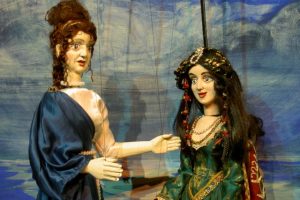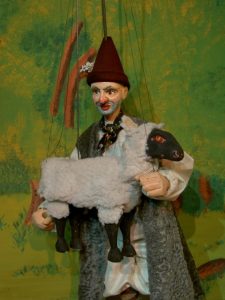L’isola di Alcina, Teatroarte Cuticchio (Palermo):
Regia di Giacomo Cuticchio, con Giacomo, Franco, Teresa, Girolamo jr, Luisa, Helenia Cuticchio.
**
Astolfo, who had been searching for Orlando, is invited by a maiden to dine with Alcina:
The hippogriff takes Ruggiero to Alcina’s island and the knight encounters Astolfo (transformed in the meantime into a myrtle tree) who warns him about Alcina:
Melissa in Merlin’s cave, summons a demon who informs her that Bradamante has lost Ruggiero, who is far away in Alcina’s island. Bradamante commands the demon to take her there:
Ruggiero, having come to his senses, repudiates Alcina, who summons her forces against Ruggiero. Battle between Ruggiero and Alcina’s ex-lovers, transformed back into human form. After Ruggiero’s victory over many, he uses the spell-breaking ring to destroy the castle and free the rest of Alcina’s prisoners. Encounter with Astolfo who has regained his body
The above excerpts from “Astolfo nell’isola di Alcina dall’Orlando Furioso” are taken from Mimmo Cuticchio: L’opera dei pupi, Sabrina Salvatorelli’s documentary on the puppet theater company Figli d’arte Cuticchio, RAI 5. (Courtesy of Giacomo Cuticchio).
See also scenes from “Astolfo nell’incanto della Maga Alcina,” a 2014 performance of the episode by Figli d’arte Cuticchio.
**
Photographs from the puppet adaptation of Caccini’s “Liberation of Ruggiero from the Island of Alcina” by the Carter Family Marionettes (2007)
Melissa and Alcina:
Shepherd:
Astolfo and a monster:
Carter Family Marionettes (Seattle, WA)
http://www.nwpuppet.org http://www.facebook.com/nwpuppet
**
AI
Two images generated by Cecilia Marchetti (University of Modena and Reggio Emilia) using DALL-E, followed by the Orlando Furioso stanzas to which they correspond and her explanation:
21
Vaghi boschetti di soavi allori,
di palme e d’amenissime mortelle,
cedri et aranci ch’avean frutti e fiori
contesti in varie forme e tutte belle,
facean riparo ai fervidi calori
de’ giorni estivi con lor spesse ombrelle;
e tra quei rami con sicuri voli
cantando se ne giano i rosignuoli.
22
Tra le purpuree rose e i bianchi gigli,
che tiepida aura freschi ognora serba,
sicuri si vedean lepri e conigli,
e cervi con la fronte alta e superba,
senza temer ch’alcun gli uccida o pigli,
pascano o stiansi rominando l’erba;
saltano i daini e i capri isnelli e destri,
che sono in copia in quei luoghi campestri.
(Orlando Furioso, VI, 21-22)
“For Italo Calvino, visibility is one of the values to be transmitted to the new millennium: it is the power to evoke images even when they are not present, the ability to think in images. This implies the use of imagination, that is, the speed in conceiving the possible and the impossible. It means having in mind a kind of electronic machine that considers all the possible combinations and selects those that best suit a purpose or simply those that are more interesting, pleasant, fun. In his words, Calvino seems to anticipate artificial intelligence and in particular DALL-E, a tool capable of transforming human language into images through a synesthetic process.
The marvelous springs from the mind of Ariosto, an author favored by Calvino, and spreads in the pages of Orlando Furioso, creating enchanted and magical places beyond the knowable and the ordinary. A clear example is the island of Alcina, a lustful and artificial Eden created by the sorceress, in which every element has a strong imaginative charge. Alcina’s island is a paradise of voluptuousness, isolated from the world, a locous amoenus designed for the pleasure of the human being. In this enchanted place, of which the sorceress is the creator, there are lush woods of laurels, palms, cedars, and oranges. There are also many animals that populate the island, such as hares, rabbits and deer, which live in harmony with nature. Alcina’s island is a dream of beauty and happiness, but also a trap for the unwary who land there.
The images produced with DALL-E are inspired by the words of Ariosto: the artificial intelligence was asked to create illustrations that recalled Renaissance painting, in particular the works of Hieronymus Bosch, populated by fantastic and improbable figures.”
Cecilia Marchetti (University of Modena and Reggio Emilia)
**
Audio recordings:
durata 26′ 03″ 3° STORIE DEI PALADINI DI FRANCIA.mp3. (MP3 audio file can be downloaded from the above link.)




